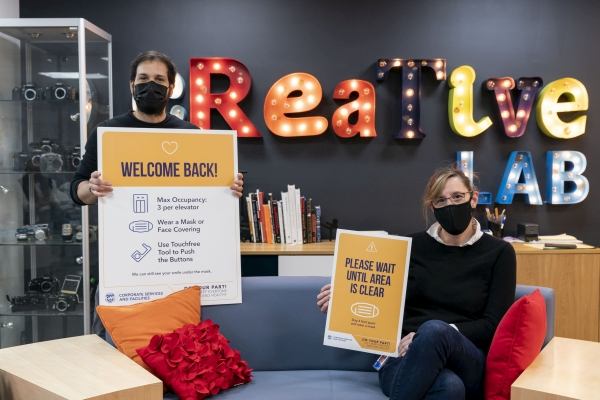What color is safety? Or, caution? How can good design keep people healthy during a pandemic? These are questions we, at IMF Creative, have been asking ourselves over the past year.
IMF Creative is the in-house agency at the International Monetary Fund, and we’re responsible for many of the visual media across the organization. For a long time, we were perceived simply as a division of graphic designers commissioned to populate slideshows with stock images. Over the past few years, we have become the key driver of the IMF’s brand and visual communication.
We serve as creative and strategic partners who help map out not just what a product will look like, but who it’s for and how it will live in the world. We turn goals into products with real-world results. And, like firms worldwide, we were forced to adjust to work at a distance in the face of the COVID-19 pandemic.
When the pandemic hit, IMF Creative began to receive design requests for a variety of different materials across divisions. We soon realized we needed a design system that would resonate with staff and help keep them safe. So, we took ad-hoc messaging on distancing, masking, etc. and consolidated it in a way that drove consistency across our facilities.
We also tapped BVA Nudge Unit—a group that specializes in crafting and fostering behaviors on an organizational level. We brought them in because we wanted our products to develop and reinforce habits among staff that would help keep them safe while in the building.
“How information is visualized has a dramatic effect on the behavior of the people receiving it,” says Harriet Tolputt, chief of IMF Creative. “Most of the decisions we make are done by our subconscious. Using design decisions, you can reinforce positive social norms and encourage safer behavior.”
Working with BVA to understand behavioral psychology helped us identify areas where signage would be most effective and which areas to avoid. “Their insights into observing not just what people were doing, but what they were not doing proved key to the campaign,” adds Tolputt.
Our creative team wanted to see how our work would be received so before we started the real design process, we took it upon ourselves to conduct video tours of actual spaces in our buildings. This way, we could identify, as a group, the ideal locations to effectively communicate with the widest possible audience.
After observing how people behave in our buildings, we compiled a playbook which we can adapt and expand as the health crisis changes. The playbook organizes all safety messaging into a hierarchy so not every sign is an urgent demand for attention. This prevents conflicting messages and signage fatigue.
Our branding ensures a homogenized type and color scheme with a clear ranking among informational, urgent and core signage.
Based on feedback from BVA Nudge Unit that our icons needed to be clearer, we also refreshed much of our icon library so graphics stand out while being more immediately intelligible in conveying safety-related concepts.
We still don’t know when we’ll be back in the office, but this process has helped us adapt to a new, more-consolidated workflow. It’s also helped us prepare our entire organization for a safer return to work.
The views expressed in this blog are those of the authors and do not necessarily represent the views of the IMF, its Executive Board, or IMF management.

